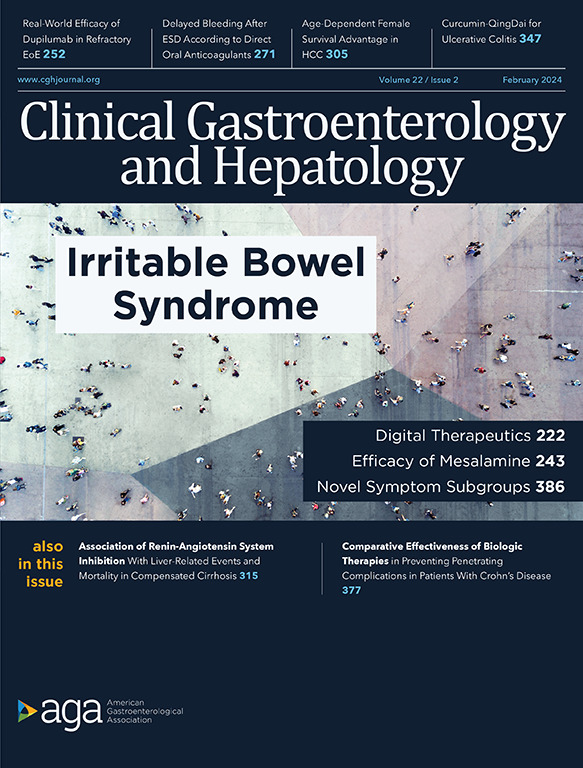A Predictive Model Based on Quantitative Fecal Immunochemical Test Can Stratify the Risk of Colorectal Cancer in an Organized Screening Program
IF 12
1区 医学
Q1 GASTROENTEROLOGY & HEPATOLOGY
引用次数: 0
Abstract
Background & Aims
A significant number of post fecal immunochemical test (FIT) colonoscopies in European-organized colorectal cancer (CRC) screening programs are performed beyond the recommended 31-day threshold due to overburdened colonoscopy services. We aimed to develop a simple predictive model to stratify CRC risk of FIT+ patients.
Methods
In a cohort of screenees undergoing colonoscopy following a positive (≥20 μg hemoglobin/g feces) OC-sensor FIT result between 2004 and 2019, we derived and validated logistic regression-based models including variables independently associated with CRC and advanced neoplasms. Odds ratios (ORs) and 95% confidence intervals (CIs) were reported.
Results
Overall, 40,276 patients (46% female; mean age, 66 ± 4 years) undergoing post FIT colonoscopy were included. Variables independently associated with CRC were age ≥70 years (OR, 1.20; 95% CI, 1.03–1.40), male sex (OR, 1.23; 95% CI, 1.11–1.37), fecal hemoglobin level (50–199 μg/g: OR, 2.84; 95% CI, 2.47–3.27; ≥200 μg/g: OR, 6.91; 95% CI, 5.99–7.98), and first round of FIT (OR, 1.53; 95% CI, 1.35–1.73). The discriminative ability of the model was good (area under the receiver operating characteristic, 0.75; 95% CI, 0.73–0.77) in the validation cohort. Applying the model would lead to over two-thirds decrease in delayed CRC diagnoses, considering various scenarios of timely colonoscopy scheduling after FIT+.
Conclusions
We derived and validated a predictive model for risk stratification of patients with positive FIT in a large CRC screening cohort. Applying our model in screening practice would allow policy makers to effectively prioritize FIT+ individuals based on the risk of CRC, substantially reducing the rate of delayed CRC diagnosis.

基于粪便免疫化学定量检测的预测模型可在有组织的筛查计划中对癌症风险进行分层。
目的:在欧洲组织的结直肠癌(CRC)筛查项目中,由于结肠镜检查服务负担过重,大量粪便免疫化学试验(FIT)后结肠镜检查超过了建议的 31 天阈值。我们的目标是建立一个简单的预测模型,对 FIT+ 患者的 CRC 风险进行分层:设计:在 2004 年至 2019 年期间,在 OC 传感器 FIT 结果呈阳性(≥ 20μg Hb/g.粪便)后接受结肠镜检查的筛查者队列中,我们推导并验证了基于逻辑回归的模型,其中包括与 CRC 和晚期肿瘤独立相关的变量。结果显示:总计有 40 276 名患者接受了 OC 检测:共纳入 40276 名接受 FIT 后结肠镜检查的患者(46% 为女性,平均年龄为 66+4 岁)。与 CRC 独立相关的变量有:年龄≥70 岁(OR 1.20,95%CI 1.03-1.40)、男性(OR 1.23,95%CI 1.11-1.37)、f-Hb 水平(50 至 199 μg/g:OR 2.84,95%CI 2.47-3.27;≥200 μg/g:OR 6.91,95%CI 5.99-7.98)和第一轮 FIT(OR 1.53,95%CI 1.35-1.73)。在验证队列中,该模型的判别能力良好(AUROC 0.75,95%CI 0.73-0.77)。考虑到 FIT+ 后及时安排结肠镜检查的各种情况,应用该模型可使延迟的 CRC 诊断减少三分之二以上:我们得出并验证了一个预测模型,用于对大型 CRC 筛查队列中的 FIT 阳性患者进行风险分层。在筛查实践中应用我们的模型将使政策制定者能够根据患 CRC 的风险有效地对 FIT+ 患者进行优先排序,从而大幅降低 CRC 延误诊断率。
本文章由计算机程序翻译,如有差异,请以英文原文为准。
求助全文
约1分钟内获得全文
求助全文
来源期刊
CiteScore
16.90
自引率
4.80%
发文量
903
审稿时长
22 days
期刊介绍:
Clinical Gastroenterology and Hepatology (CGH) is dedicated to offering readers a comprehensive exploration of themes in clinical gastroenterology and hepatology. Encompassing diagnostic, endoscopic, interventional, and therapeutic advances, the journal covers areas such as cancer, inflammatory diseases, functional gastrointestinal disorders, nutrition, absorption, and secretion.
As a peer-reviewed publication, CGH features original articles and scholarly reviews, ensuring immediate relevance to the practice of gastroenterology and hepatology. Beyond peer-reviewed content, the journal includes invited key reviews and articles on endoscopy/practice-based technology, health-care policy, and practice management. Multimedia elements, including images, video abstracts, and podcasts, enhance the reader's experience. CGH remains actively engaged with its audience through updates and commentary shared via platforms such as Facebook and Twitter.

 求助内容:
求助内容: 应助结果提醒方式:
应助结果提醒方式:


